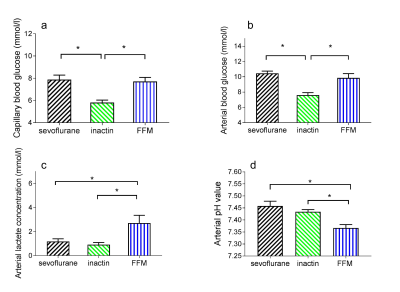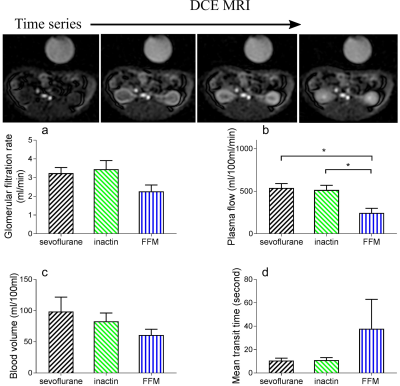4603
Effects of anesthesia on renal function and metabolism in rats1MR Research Centre, Department of Cinical Medicine, Aarhus University, Århus N, Denmark
Synopsis
Performing MRI of animals typically requires anesthesia. However, anesthesia is known to modulate a wide variety of important metabolic and functional processes, and as such represents potential limitations in study design.
Here we investigated renal functional and metabolic consequences of three typical rodent anesthetics of sevoflurane, inactin and a mixture of fentanyl, fluanisone and midazolam (FFM), with hyperpolarized [1-13C] pyruvate MRI and DCE imaging. FFM increased renal lactate/pyruvate ratio and blood lactate concentration. Inactin and sevoflurane had reasonable renal metabolism and function. The results indicate inactin and sevoflurane are preferable when renal metabolism and function are the consideration of research.
Purpose
To investigate the renal functional and metabolic influences of three typical rodent anesthetics used in pre-clinical MRI: sevoflurane, inactin and FFM mixture.
Methods
Eighteen ten-week old, female Wistar rats (240.1± 2.67 g) were anesthetized with sevoflurane, inactin or FFM (n=six for each group). In the sevoflurane group, rats were anesthesized in a gas-chamber using 7-8 % sevoflurane in 2 l/min air, then maintained with 2.5 % sevoflurane in 2 l/min air. In the inactin group, rats were anesthetized by subcutaneous injection of inactin solution with 120 mg per kg body weight. In the FFM anesthesia group, each rat was anesthetized with 0.2 ml FFM mixture (1.25 mg/ml midazolam, 2.5 mg/ml fluanisone and 0.079 mg/ml fentanyl citrate) per 100 g body weight by subcutaneous injection and administration of 0.1 ml FFM mixture per 100 g body weight every 30 min after anesthesia induction. Adequate depth of anesthesia was determined by the reaction to pedal withdrawal reflex. A 0.4 mm catheter was subsequently inserted into the tail vein for administration of hyperpolarized [1-13C] pyruvate. Temperature, oxygen saturation and respiration rate were monitored throughout the experiment. After an equilibration period of about 45-60 min anesthesia, the hyperpolarized magnetic resonance (MR) examinations were performed in a 3.0 T clinical MR system (GE healthcare) equipped with a dual tuned 13C/1H volume rat coil (GE healthcare, Brøndby, DK). Parameters were as follows: Flip angle=10º, 11 IDEAL echoes and one initial spectrum per IDEAL encoding, TR/TE/ΔTE=100 ms / 0.9 ms / 0.9 ms, FOV=80 x 80 mm2, 5 x 5 mm2 real resolution and an axial oblique slice thickness of 15 mm covering both kidneys. Dynamic contrast-enhanced (DCE) MRI using gadolinium was applied for measuring renal glomerular filtration rate and renal plasma flow afterwards. After finishing the MR scanning protocol, 1 ml arterial blood collected from the aortic bifurcation was analyzed immediately with an ABL-90 blood gas analyzer (Radiometer Medical ApS, Brønshøj, DK).Results
A similar body weight and kidney weight were observed between the three groups, whereas the rats receiving sevoflorane or FFM mixture had higher blood glucose level than rats receiving inactin (p<0.005) (Fig. 1a and b). Arterial lactate concentration was higher and pH value was lower (Fig. 1d) in the FFM group than in the sevoflurane and inactin groups (Fig. 1c). No significant difference was found in blood pressure (Fig. 2). A statistically significant renal increase in 13C-lactate / 13C-pyruvate ratio (p=0.009) was observed in kidneys of rats under FFM mixture anesthesia (Fig. 3a). DCE functional MRI showed rats with FFM anesthesia had lower plasma flow in the renal cortex (p=0.003) (Fig. 4b) and higher variance in mean transit time (Fig. 4d).Discussion and conclusion
This study demonstrates the influence of three different anesthetics on renal metabolic and function using hyperpolarized MRI and DCE imaging in rats. Inactin and sevoflurane were found to affect the renal function and metabolic status to a lesser degree than the FFM mixture. FFM mixture anesthesia increased renal lactate/pyruvate ratio and the arterial blood lactate concentration, as well as lower pH value. The decreased renal blood flow and maintained GFR in the FFM group might in part explain the increased renal lactate production. The FFM mixture has previously been demonstrated to impact myocardial function and metabolic status in rodents1. Sevoflurane anesthesia is particularly easy to induce and maintain during the whole anesthesia procedure in the MR applications, and as such represents a good alternate to inactin (endpoint only anesthetic), although sevoflurane alters the blood glucose level2.Acknowledgements
Henrik Vestergaard Nielsen is acknowledged for his expert laboratory assistance.References
1. Ter Horst EN, Krijnen PAJ, Flecknell P, et al. Sufentanil-medetomidine anaesthesia compared with fentanyl/fluanisone-midazolam is associated with fewer ventricular arrhythmias and death during experimental myocardial infarction in rats and limits infarct size following reperfusion. Lab Anim. 2017 Jan
2. Kitamura T, Ogawa M, Kawamura G, et al. The effects of sevoflurane and propofol on glucose metabolism under aerobic conditions in fed rats. Anesth Analg. 2009 Nov;109(5):1479-85.
Figures



